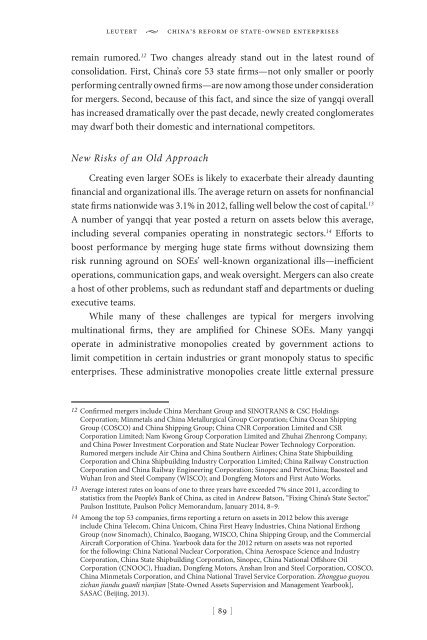Create successful ePaper yourself
Turn your PDF publications into a flip-book with our unique Google optimized e-Paper software.
leutert • china’s reform of state-owned enterprises<br />
remain rumored. 12 Two changes already stand out in the latest round of<br />
consolidation. First, China’s core 53 state firms—not only smaller or poorly<br />
performing centrally owned firms—are now among those under consideration<br />
for mergers. Second, because of this fact, and since the size of yangqi overall<br />
has increased dramatically over the past decade, newly created conglomerates<br />
may dwarf both their domestic and international competitors.<br />
New Risks of an Old Approach<br />
Creating even larger SOEs is likely to exacerbate their already daunting<br />
financial and organizational ills. The average return on assets for nonfinancial<br />
state firms nationwide was 3.1% in 2012, falling well below the cost of capital. 13<br />
A number of yangqi that year posted a return on assets below this average,<br />
including several companies operating in nonstrategic sectors. 14 Efforts to<br />
boost performance by merging huge state firms without downsizing them<br />
risk running aground on SOEs’ well-known organizational ills—inefficient<br />
operations, communication gaps, and weak oversight. Mergers can also create<br />
a host of other problems, such as redundant staff and departments or dueling<br />
executive teams.<br />
While many of these challenges are typical for mergers involving<br />
multinational firms, they are amplified for Chinese SOEs. Many yangqi<br />
operate in administrative monopolies created by government actions to<br />
limit competition in certain industries or grant monopoly status to specific<br />
enterprises. These administrative monopolies create little external pressure<br />
12 Confirmed mergers include China Merchant Group and SINOTRANS & CSC Holdings<br />
Corporation; Minmetals and China Metallurgical Group Corporation; China Ocean Shipping<br />
Group (COSCO) and China Shipping Group; China CNR Corporation Limited and CSR<br />
Corporation Limited; Nam Kwong Group Corporation Limited and Zhuhai Zhenrong Company;<br />
and China Power Investment Corporation and State Nuclear Power Technology Corporation.<br />
Rumored mergers include Air China and China Southern Airlines; China State Shipbuilding<br />
Corporation and China Shipbuilding Industry Corporation Limited; China Railway Construction<br />
Corporation and China Railway Engineering Corporation; Sinopec and PetroChina; Baosteel and<br />
Wuhan Iron and Steel Company (WISCO); and Dongfeng Motors and First Auto Works.<br />
13 Average interest rates on loans of one to three years have exceeded 7% since 2011, according to<br />
statistics from the People’s Bank of China, as cited in Andrew Batson, “Fixing China’s State Sector,”<br />
Paulson Institute, Paulson Policy Memorandum, January 2014, 8–9.<br />
14 Among the top 53 companies, firms reporting a return on assets in 2012 below this average<br />
include China Telecom, China Unicom, China First Heavy Industries, China National Erzhong<br />
Group (now Sinomach), Chinalco, Baogang, WISCO, China Shipping Group, and the Commercial<br />
Aircraft Corporation of China. Yearbook data for the 2012 return on assets was not reported<br />
for the following: China National Nuclear Corporation, China Aerospace Science and Industry<br />
Corporation, China State Shipbuilding Corporation, Sinopec, China National Offshore Oil<br />
Corporation (CNOOC), Huadian, Dongfeng Motors, Anshan Iron and Steel Corporation, COSCO,<br />
China Minmetals Corporation, and China National Travel Service Corporation. Zhongguo guoyou<br />
zichan jiandu guanli nianjian [State-Owned Assets Supervision and Management Yearbook],<br />
SASAC (Beijing, 2013).<br />
[ 89 ]


